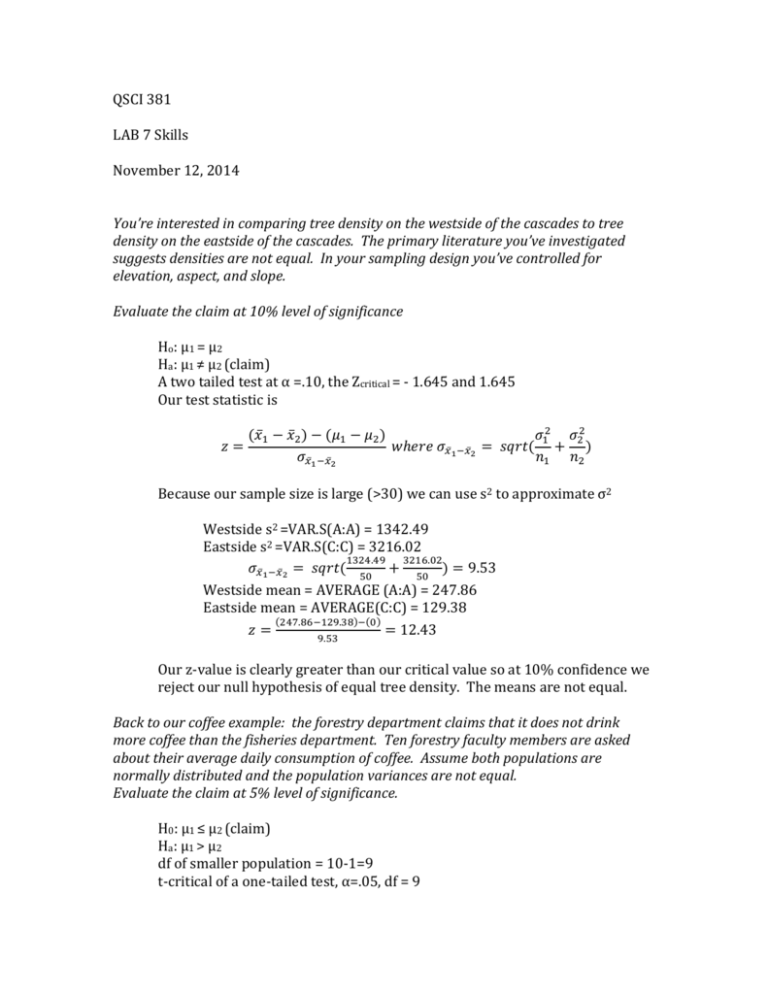Lab7_Skills
advertisement

QSCI 381 LAB 7 Skills November 12, 2014 You’re interested in comparing tree density on the westside of the cascades to tree density on the eastside of the cascades. The primary literature you’ve investigated suggests densities are not equal. In your sampling design you’ve controlled for elevation, aspect, and slope. Evaluate the claim at 10% level of significance Ho: µ1 = µ2 Ha: µ1 ≠ µ2 (claim) A two tailed test at α =.10, the Zcritical = - 1.645 and 1.645 Our test statistic is 𝑧= (𝑥̅1 − 𝑥̅2 ) − (𝜇1 − 𝜇2 ) 𝜎12 𝜎22 𝑤ℎ𝑒𝑟𝑒 𝜎𝑥̅ 1 −𝑥̅2 = 𝑠𝑞𝑟𝑡( + ) 𝜎𝑥̅ 1 −𝑥̅2 𝑛1 𝑛2 Because our sample size is large (>30) we can use s2 to approximate σ2 Westside s2 =VAR.S(A:A) = 1342.49 Eastside s2 =VAR.S(C:C) = 3216.02 1324.49 3216.02 𝜎𝑥̅ 1 −𝑥̅2 = 𝑠𝑞𝑟𝑡( 50 + 50 ) = 9.53 Westside mean = AVERAGE (A:A) = 247.86 Eastside mean = AVERAGE(C:C) = 129.38 (247.86−129.38)−(0) 𝑧= = 12.43 9.53 Our z-value is clearly greater than our critical value so at 10% confidence we reject our null hypothesis of equal tree density. The means are not equal. Back to our coffee example: the forestry department claims that it does not drink more coffee than the fisheries department. Ten forestry faculty members are asked about their average daily consumption of coffee. Assume both populations are normally distributed and the population variances are not equal. Evaluate the claim at 5% level of significance. H0: µ1 ≤ µ2 (claim) Ha: µ1 > µ2 df of smaller population = 10-1=9 t-critical of a one-tailed test, α=.05, df = 9 =T.INV(.05, 9) = 1.833 (𝑥̅1 − 𝑥̅2 ) − (𝜇1 − 𝜇2 ) 𝑠12 𝑠22 𝑡= 𝑤ℎ𝑒𝑟𝑒 𝑠𝑥̅1 −𝑥̅2 = 𝑠𝑞𝑟𝑡 ( + ) 𝑠𝑥̅1 −𝑥̅2 𝑛1 𝑛2 Variance fisheries = VAR(A:A) = 1.88 Variance forestry = VAR(C:C) = 0.66 Mean fisheries = AVERAGE(C:C) = 1.9 Mean forestry = AVERAGE(C:C) = 2 𝑠𝑥̅1 −𝑥̅ 2 = 𝑠𝑞𝑟𝑡( 𝑠12 𝑠22 1.882 . 662 + ) = 𝑠𝑞𝑟𝑡( + ) = 0.504 𝑛1 𝑛2 10 10 (1.9 − 2) − 0 𝑡= = .198 . 5044 Our calculated test statistic is not in the rejection region. At 5% level of significance we fail to reject the null hypothesis that forestry does not drink more coffee than fisheries. In the last problem, we assumed the population variances were not equal. Use an Ftest to determine if the variances are equal at 10% level of significance. State the hypotheses H0: 𝜎12 = 𝜎22 Ha: 𝜎12 ≠ 𝜎22 (claim) Determine degrees of freedom First determine which variance is the numerator and which is the denominator. Fisheries coffee consumption has greater variance than forestry coffee consumption so fisheries is the numerator. d.f.N = n1-1 = 10-1=9 d.f.D = n2-1 = 10-1=9 Find our critical values α=.10. We have a two-tailed test so we use (1/2)α = .05 Our critical value is 3.18 from table 7 Or =F.INV.RT(0.05,9,9) Sketch the rejection region Compute the test statistic 𝑠2 1.88 2 .67 𝐹 = 𝑠12 = = 2.82 Or try data analysis -> f-test and select the data you’d like Make your decision 2.82 does not fall within the rejection region (3.18). We fail to reject our null hypothesis. With 10% level of significance the variances are not statistically different. You’re working on a black bear study in the North Cascades. As part of the study you capture, weigh, and radio collar 10 male bears just before hibernation. Once the bears emerge from hibernation you re-capture them and weigh them again. You want to test the claim that bears lose weight during hibernation. State the null and alternative hypothesis H0: μd ≤ 0 Ha: μd > 0 (claim) If bears loose weight, before-after = + value so μd will be positive (>0) At α=.05, find the critical value (what distribution should you use?) Use the t-distribution Df = 10-1=9 t0 = 1.833 = T.INV (.95, 9) Calculate the test statistic ∑𝑑 505.96 𝑑̅ = 𝑛 = 10 = 50.596 Calculate the standardized test statistic and interpret. Sum(d^2)= 255995.5216 STDEV.S=25.867 𝑡= 𝑑̅ − 𝜇𝑑 𝑠𝑑 𝑠𝑞𝑟𝑡(𝑛) = 50.596 − 0 = 6.185 25.867 𝑠𝑞𝑟𝑡(10) t > t0. At 5% level of significance, there is enough evidence to reject the null hypothesis that bears do not loose weight. Notice that this is the same as calculating a t-statistic on the d column (7.3 t-test of sample) 𝑡= 𝑥̅ − 𝜇 50.596 − 0 = = 6.185 𝑠/𝑠𝑞𝑟𝑡(𝑛) 25.867/𝑠𝑞𝑟𝑡(10) Now the easy way…. Data analysis data analysis t-test: paired two sample for means Select column 1 as variable 1 Select column 2 as variable 2 Set the alpha level t-Test: Paired Two Sample for Means Mean Variance Observations Pearson Correlation Hypothesized Mean Difference df t Stat P(T<=t) one-tail t Critical one-tail P(T<=t) two-tail t Critical two-tail Variable 1 257.1 4565.877778 10 0.95880264 Variable 2 206.504 2251.288516 10 0 9 6.185335907 8.08448E-05 1.833112933 0.00016169 2.262157163 We can see that our t-stat > t-critical so we reject the null hypothesis. Also notice that the p-value for one-tail < .05 so we reject the null hypothesis








